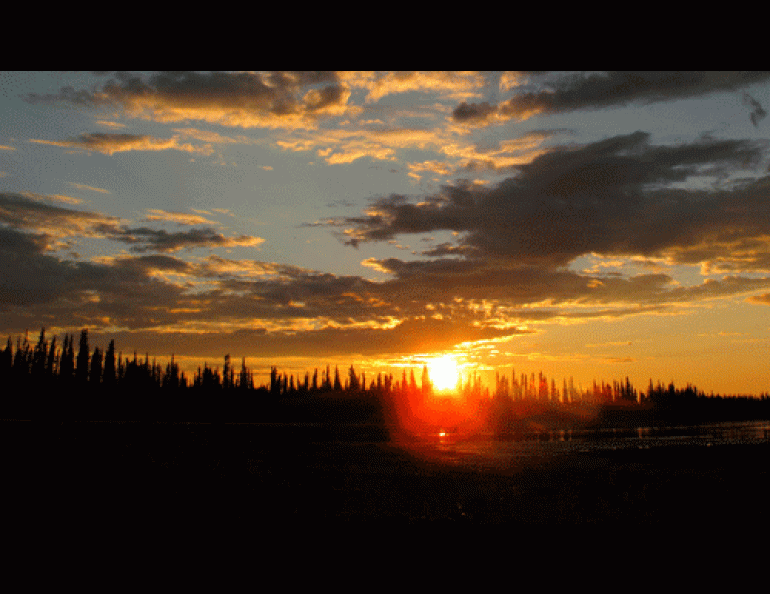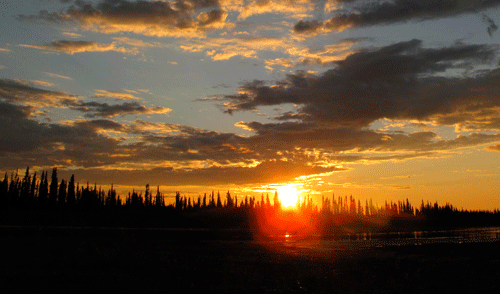
Notes from AGU's 2010 Fall Meeting
My notebook is full from my visit to the American Geophysical Union’s Fall Meeting in San Francisco, which convened for a week in December 2010. Here’s some Alaska-related news:
Barrow lakes are getting greener. A student from the University of Texas at El Paso traveled to Barrow last summer to sample the vegetation from lakes and ponds outside town. Christian Andresen compared his measurements with those done by scientists in the 1970s. He found that aquatic plants in the lakes were both greener and more abundant than they were 40 years ago. “There were more plants and the nutrients in the water have increased,” Andresen said in San Francisco’s Moscone Center. “These ponds are very abundant aquatic ecosystems.” Andresen, born in El Paso and raised in Tampico, Mexico, is now writing up his results to earn his doctorate.
The Great Kobuk Sand Dunes are like Mars. Last March, guided by Alaska author and area resident Seth Kantner, Cynthia Dinwiddie of San Antonio traveled by snowmachine to the Great Kobuk Sand Dunes in northwest Alaska. Near Kobuk Valley National Park, she bunked for a few weeks at a cabin owned by Ambler resident Clarence Wood. The researcher from the Southwest Research Institute and a few of her colleagues dug several boreholes and pulled ground-penetrating radar sensors over the snow-covered dunes with snowmachines. The team sought to compare the unusual area with the surface of Mars. “Everything that this system represents you can find on Mars,” Dinwiddie said. “Dunes on Mars move slowly (due to winds) and so do dunes in the Kobuk Valley.” A surprise of the researchers’ visit was the discovery of unfrozen water beneath the dunes, at the base of the active layer (ground that freezes every winter, which in the dunes is from about four to 12 feet thick beneath the surface). “We found water everywhere,” Dinwiddie said.
Southwest Alaska wolves are not just eating moose and caribou. A few years ago, biologists in Southeast Alaska reported that good portions of wolf diets in the region included salmon, which surprised some people who thought that wolves ate almost nothing except red meat. In San Francisco, University of Alaska Anchorage graduate student Ashley Stanek presented a poster on her studies of wolves farther north, near Lake Clark and the Alaska Peninsula. She has looked at guard hairs and blood samples of wolves from four packs in the area. Biologists capture the radio-collared wolves to take the samples, which Stanek and others analyze using stable isotope analysis. “The collars tell us where they are,” said Stanek. “The isotopes tell us what they are eating.” Her early results show that two wolf packs with territories centered on thriving salmon streams and rivers show more ocean-derived foods (probably salmon) in their diets than those that wander farther from waterways. As for wolves choosing to eat salmon, Stanek said it makes sense to her. “It’s an easy resource, it’s high in protein, and high in fat.”
Bears are eating just about everything. During a 10-year period, brown bears in southwest Alaska had a diet that averaged about 39 percent salmon, 25 percent berries, 14 percent mammals and about 9 percent of both freshwater fish and vegetation, according to Craig Stricker, a United States Geological Survey biologist who works in Denver. Stricker teamed with Alaska biologists to examine information from guard hairs (which grow during the summer after a bear emerges from hibernation) of brown bears from the Kuskokwim Mountains. “Bears respond to what’s available,” Stricker said in San Francisco. “(Results) show less salmon eaten during the salmon crash beginning in 1997 to 2000, and they suggest that bears are creatures of habit — that there’s salmon-eating bears and vegetation-eating bears.”
Alaska trees are reacting to warmer air. “Warming is not good for black and white spruce,” said Pieter Beck of Woods Hole Research Center in Massachusetts. “Drought is limiting productivity; only (far-northern) tundra is showing a positive response to warmer weather.” Beck gave a presentation during which he spoke of his work in collaboration with many Alaska researchers. Over the years, they pulled cores from trees in 88 dense stands throughout the state and used tree ring data to check how trees have fared since 1982. He said spruce trees in the northern Interior have suffered in warmer temperatures, while those in southern Alaska (he gave an example of trees near Dillingham) have become more productive. “Unless forest migration can keep pace with increased tree mortality due to drought, we expect to see a recession of the boreal forest rather than a simple northern shift,” Beck said.





